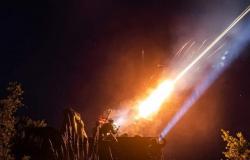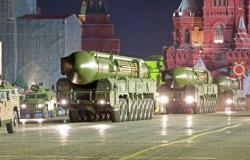The latest news from the Ukrainian front was rather gloomy, talking about Kiev’s disadvantage in terms of weapons and combat power and the expected Russian assault. However, experts and officials quoted by the Financial Times believe that, for now, Russia does not have a major advantage in any chapter and that the offensive that could begin in May or June will not give Moscow a serious advance on the battlefield.
A Russian soldier launches an anti-tank missile on the Ukrainian frontPhoto: Russian Defense Ministry Press Service / AP / Profimedia
Russia has assured in recent days that the American weapons that will arrive in Ukraine, after the approval of the aid package in the US Congress, will not change the situation on the battlefield.
Officials in Moscow have warned that this additional aid will only prolong the agony and increase the number of Ukrainian dead on the battlefield.
And more than at any time since Vladimir Putin ordered the invasion of Ukraine two years ago, the Russian president seems “very confident and happy,” a person who knows him well told the Financial Times.
Russia is indeed in a good moment. With Kiev facing an ammunition and weapons crisis and its troops increasingly depleted, Moscow’s forces have taken advantage of their superior firepower and made some progress on the front line.
Some warnings went so far as to suggest that Ukraine could lose the war by the end of the year.
Officials and observers explained that Russia’s multiple attacks along large areas of the front, repeated strikes on the city of Kharkiv and countless guided bombs dropped on Ukrainian defenders are aimed at destabilizing this defense in anticipation of a larger offensive to come.
Kiev anticipated that this major assault should take place in the months of May-June. The question now is what impact this offensive will have, especially as Kiev’s troops will still enjoy an infusion of weapons and ammunition after the congressional vote.
A Western official told the Financial Times that while Russia may make some tactical progress on the front line, it still has an ineffective military with old equipment and poorly trained soldiers and will not “overwhelm” Ukraine.
“In February 2022, Russia had a much better equipped and trained military,” the official added, referring to Russia’s initial invasion and subsequent landing in northern Ukraine.
A bigger arsenal than Ukraine’s, but without a radical advantage
Ukrainian experts and military have repeatedly noted that Russia now has a significant advantage in artillery, which ensures its slight advance in some points of the front.
Russia fires five shells for every shell fired by the Ukrainians, or even more, up to ten, in some areas.
“The (US) aid will not negate Russian advantages this year, but it will allow Ukrainian forces to defend their positions with counter-battery fire and can be used to slow or stop Russian advances,” Dara Massicot explained to the Financial Times. researcher at the Carnegie Endowment for International Peace, who studies the Russian military.
Russia’s military industry has increased production several times over, with factories working around the clock, according to officials.
Sergei Chemezov, the head of Rostec, the state defense conglomerate, said last November that Russia was producing 2.5 times more artillery and multiple launch systems than before, while production of some types of ammunition had increased from 60 times.
Still, analysts say, those numbers simply mask Moscow’s inability to turn that firepower into meaningful success on the battlefield — something that would only be possible with more advanced weaponry.
Western sanctions have made it harder to obtain components for drones, guided bombs and high-precision missiles, forcing Moscow to rely on lower-tech weapons it can more easily mass-produce.
Despite Moscow’s larger arsenal, its military “does not have a radical advantage over Ukraine in terms of artillery and ammunition,” said Ruslan Pukhov, head of the Center for Analysis of Strategies and Technologies, a Moscow-based defense think tank. .
Instead, the Kremlin is deploying less sophisticated weaponry, such as highly destructive bombs and refurbished Soviet weaponry, while mobilizing troops using motorcycles and all-terrain vehicles.
Then, despite the increased firepower at the moment, Russia still cannot maintain the enormous rate of shells launched in the first months of the war.
The Ministry of Defense has admitted that it can only produce at most half of the 4 million 152mm and 1.6 million 122mm projectiles that Putin’s military estimates it needs to penetrate Ukrainian defenses.
And as Russia continues to fire more shells, it wears out its artillery barrels faster than it can produce new ones — forcing it to replace them with Soviet-era barrels.
Russia would need a mobilization
The US aid does not address what Ukrainian and Western officials say is Kiev’s most obvious problem – the inability to cope with the enormous numbers of people Russia has called up to fight.
Ukraine has passed a new mobilization law and launched a campaign to recruit volunteers, but experts have warned that Kiev needs a full-scale mobilization to address its severe troop shortage.
Andrii Yusov, a spokesman for Ukraine’s military intelligence services, said Russia, which controls 18 percent of Ukrainian territory, has between 450,000 and 470,000 soldiers fighting in Ukraine, in addition to the 35,000 members of the national guards, such as and the separate air force and naval operations that take place.
Despite a superiority in this chapter, Russia is not in an ideal position either.
A summer offensive would require Putin to declare a new round of mobilization, Carnegie Endowment for International Peace expert Massicot told the Financial Times.
“If the Kremlin has ambitions for Kharkiv, or something even more difficult, like southern Ukraine, then it will have to generate a very large force, probably well over 100,000 for both (points), plus the equipment,” Massicot said.
And ultimately, even if Russia were to recruit more people, the numbers simply wouldn’t be enough to compensate for their lack of training, said Pavel Luzin, a researcher at the Center for European Policy Analysis, a think tank. based in Washington.
“We all talk about mobilization, but where are the commanders, sergeants and lieutenants, who would command the mobilized soldiers?” he asked.
Tags: Analysis lift Kievs morale Russia launch major offensive year
-





